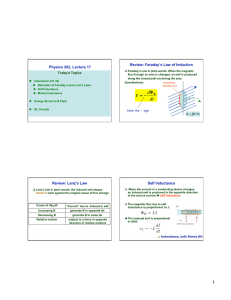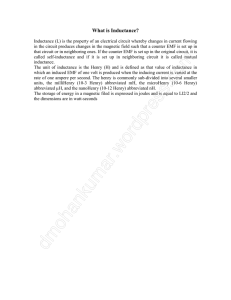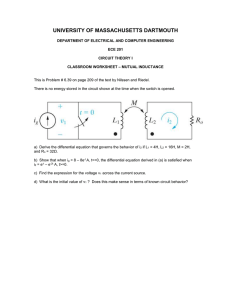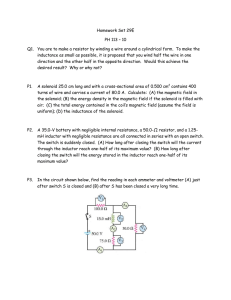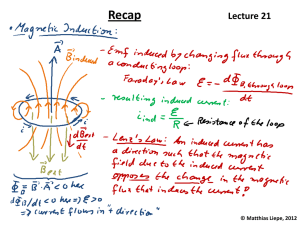d dt d B Φ − =
advertisement
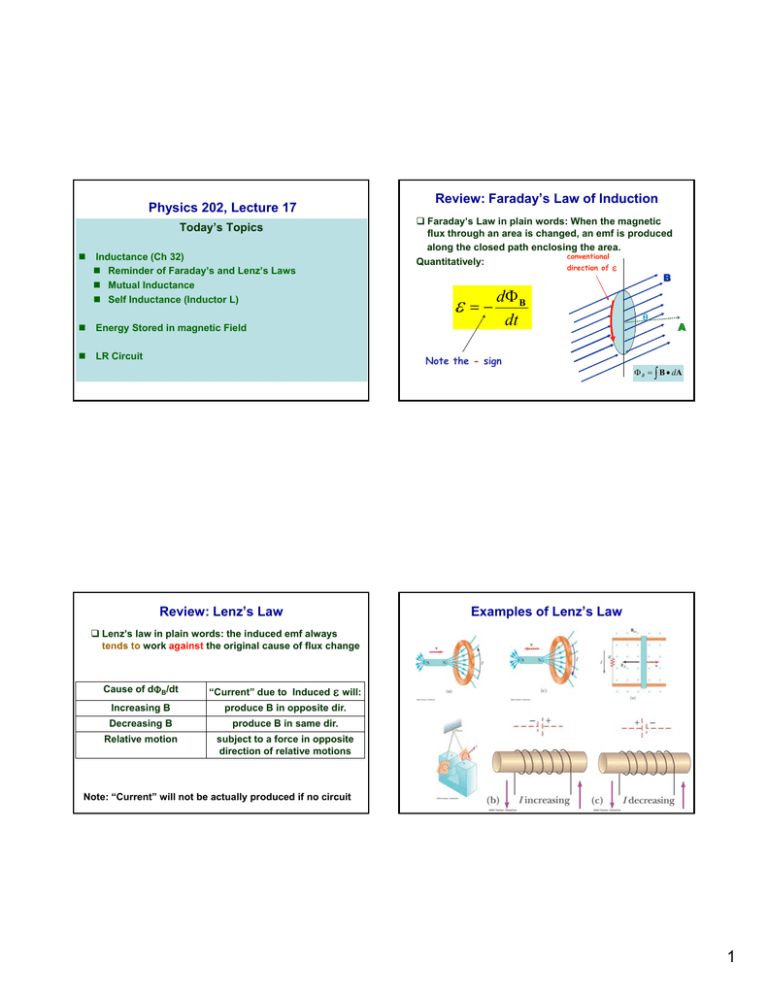
Physics 202, Lecture 17 Today’s Topics Inductance (Ch 32) Reminder of Faraday’s and Lenz’s Laws Mutual Inductance Self Inductance (Inductor L) Energy Stored in magnetic Field LR Circuit Review: Faraday’s Law of Induction Faraday’s Law in plain words: When the magnetic flux through an area is changed, an emf is produced along the closed path enclosing the area. conventional Quantitatively: direction of ε B ε = − dΦ B dt Note the - sign Review: Lenz’s Law θ A Φ B = ∫ B • dA Examples of Lenz’s Law Lenz’s law in plain words: the induced emf always tends to work against the original cause of flux change Cause of dΦB/dt “Current” due to Induced ε will: Increasing B produce B in opposite dir. Decreasing B produce B in same dir. Relative motion subject to a force in opposite direction of relative motions Note: “Current” will not be actually produced if no circuit 1 Mutual Inductance Magnetically Coupled Coils (Transformers) For coupled coils: ε 1 N1 = ε 2 N2 ε2 = - M12 dI1/dt ε1 = - M21 dI2/dt Can prove (not in class): M12=M21=M Æ M: mutual inductance (unit: Henry) N1 N2 ε2 = - M dI1/dt ε1 = - M dI2/dt Question: Why use iron core? Self Inductance When the current in a conducting device changes, an induced emf is produced in the opposite direction of the source current. Æ self inductance. Exercise: Calculate Inductance of a Solenoid (Text example 32.1) show that for an ideal solenoid: L= (see board) The magnetic flux due to self inductance is proportional to I: ΦB= LI ÎThe induced emf is proportional to dI/dt: εL = - L dI/dt L: Inductance, unit: Henry (H) μ0 N 2 A Area: A l l # of turns: N B =μ0nI (ideal case, recall Apere’s Law) 2 Charging and Discharging LR Circuit Inductors I=0 Dis-Charging Before I Energy in an Inductor The work needed to increase the current in an inductor from zero to some value I Transient Stabilized I=i(t) Before When an inductor of inductance L is carrying a current changing at a rate dI/dt, the power supplied is I=Imax=ε/R I=i(t) Charging Inductance is intrinsic to a conductive circuit. Two factors that determine the inductance: Geometric configuration of the circuit Filling of magnetic material. Specifically configured inductance devices (inductors) are very useful in electronic and electrical applications: I=0 After Transient Energy in a Magnetic Field U= ½ Solenoid: B =μ0 N/l I and L= μ0 N2A/l Æ U= ½ B2/μ0 (Al) LI2 ¾ The energy is in the form of B field: energy gy density: y uB = ½ B2/μ μ0 (recall: uE= ½ ε0E2) Solenoid as example Compare: Inductor: energy stored U= ½ LI2 Î ½ B2/μ0 Capacitor: energy stored U= ½ C(ΔV)2 Î ½ ε0E2 Resistor: no energy stored, (all energy consumed ) 3 Basic Circuit Components Component Symbol Behavior in circuit Ideal battery, emf ΔV=V+-V- =ε Resistor ΔV= -IR ε r Realistic Battery LR Circuit Æ Current as a function of time after switching on: I(t) I (t ) = (Ideal) wire Capacitor ΔV=0 (ÆR=0, L=0, C=0) ΔV=V- - V+ = - q/C, dq/dt =I Inductor ΔV= - LdI/dt (Ideal) Switch L=0, C=0, R=0 (on), R=∞ (off) ε R (1 − e − t L/R ) switching on at t=0 ε − L dI (t ) − RI (t ) = 0 dt Transformer Diodes, Transistors,… Future Topics Note: the time constant is τ=L/R Quiz: What is the current when t=∞ ? Turn on LR Circuit: Algebra Details Homework: “Switching off” LR Circuit: Time Constant turning on turning off Apply Kirchhoff loop rule I= t − V I = 0 (1− e L / R ) R t − V0 (1− e L / R ) R I = I 0e − t L /R Time Constant of the LR circuit: τ=L/R 4

